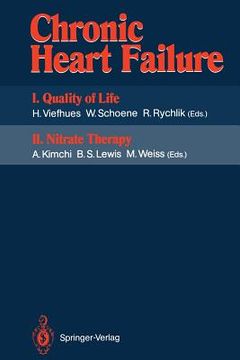Share
chronic heart failure: i. quality of life ii. nitrate therapy (in English)
Herbert Viefhues
(Illustrated by)
·
Wolfgang Schoene
(Illustrated by)
·
R. Rychlik
(Illustrated by)
·
Springer
· Paperback
chronic heart failure: i. quality of life ii. nitrate therapy (in English) - Viefhues, Herbert ; Schoene, Wolfgang ; Rychlik, R.
$ 104.20
$ 109.99
You save: $ 5.79
Choose the list to add your product or create one New List
✓ Product added successfully to the Wishlist.
Go to My WishlistsIt will be shipped from our warehouse between
Monday, May 20 and
Tuesday, May 21.
You will receive it anywhere in United States between 1 and 3 business days after shipment.
Synopsis "chronic heart failure: i. quality of life ii. nitrate therapy (in English)"
A. Schneeweiss Although the syndrome of congestive heart failure has been recognized many years ago, the approach for its evaluation and treatment has until recently, been partial and 'fragmentary'. Various aspects of the disease have been treated according to the evaluation tools and therapeutic measures available at each period. This approach resulted in some of the greatest achievements in the management of heart failure but also left many aspects neglected and also resulted in several paradoxes. Examples of the achievements and limitations of the 'fragmentary' ap- proach are the use of diuretics and hemodynamic measurements. The devel- opment of diuretics has provided us with an important tool for helping pa- tients whose predominant problem was edema. The success of diuretics masked the fact that their use may often be hemodynamically unsound and that they may reduce cardiac output. Only many years after their introduction has the use of diuretics found its appropriate place. Hemodynamic monitoring has gone via the same path. The great contribu- tion of continuous bedside hemodynamic measurements to understanding heart failure resulted in over-usage by many clinicians, who found themselves treating hemodynamic charts rather than patients. It took almost a decade to realize that hemodynamic improvement, even in the chronic setting, does not necessarily mean symptomatic improvement or an increase in exercise capac- ity.
- 0% (0)
- 0% (0)
- 0% (0)
- 0% (0)
- 0% (0)
All books in our catalog are Original.
The book is written in English.
The binding of this edition is Paperback.
✓ Producto agregado correctamente al carro, Ir a Pagar.

